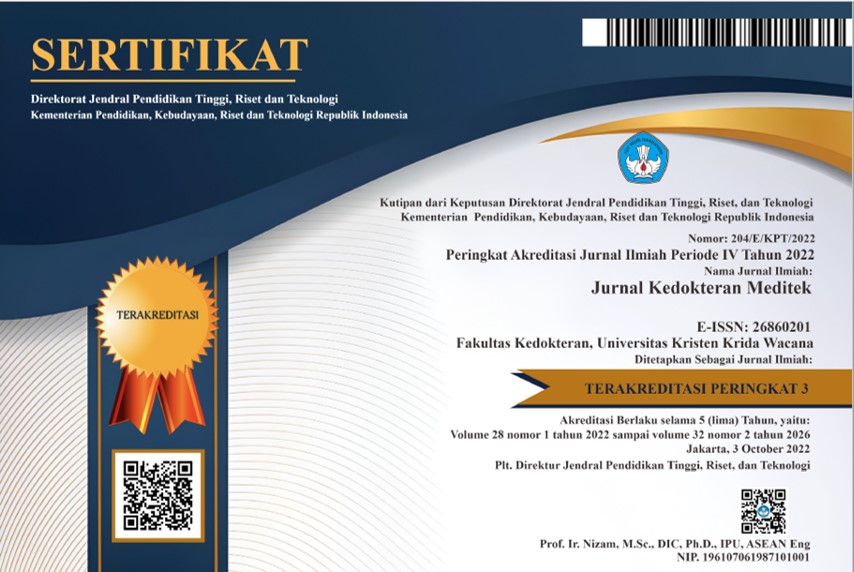Efektivitas Extraoral Suction dalam Praktik Kedokteran Gigi di Masa Pandemi COVID-19
DOI:
https://doi.org/10.36452/jkdoktmeditek.v26i3.1919Keywords:
Aerosol, COVID-19, Dentistry, Extraoral SuctionAbstract
COVID-19 virus can be potentially transmitted by aerosol. Aerosol is defined as small particles of less than 0.5-10 micron which can be produced during talking, coughing and sneezing. In addition, aerosol can be produced by instrumentation during dental procedure. The purpose of this literature review is to explain the effectiveness of extra-oral suction usage for reducing aerosol production and circulation during dental procedure. COVID-19 virus brought by aerosol tend to stay airborne for 3 hours with 1.1-1.2 hours of lifespan. By using aerosol as transport media, virus can travel almost 200.000 km horizontally. A combination of intra- and extra-oral suction in dental clinics or hospitals are believed to be effective for reducing the risk of COVID-19 transmission by aerosol during dental practice. The study recommends further research by microbiology specialists and dental technology experts to confirm this.
References
2. Ahmed M, Jouhar R, Ahmed N, et al. Fear and practice modifications among dentists to combat novel coronavirus disease (COVID-19) outbreak. International Journal of Environmental Research and Public Health. 2020;17(8).
3. Shereen M, Khan S, Kazmi A, et al. COVID-19 infection: Origin, transmission, and characteristics of human coronaviruses. Journal of Advanced Research. 2020;24:91–8.
4. Baghizadeh M. What dentists need to know about COVID-19. Oral Oncology. 2020;105:104741.
5. Ather A, Patel B, Ruparel N, et al. Coronavirus disease 19 (COVID-19): Implications for clinical dental care. Journal of Endodontics. 2020;46(5):584–95.
6. Lucaciu O, Tarczali D, Petrescu N. Oral healthcare during the COVID-19 pandemic. Journal of Dental Sciences. 2020;40:10–3.
7. Kerawala C, Riva F. Aerosol-generating procedures in head and neck surgery – can we improve practice after COVID-19? British Journal of Oral and Maxillofacial Surgery. 2020:58(6):704–7.
8. Aldahlawi A, Afifi K. COVID-19 in dental practice: Transmission risk, infection control challenge, and clinical implications. The Open Dentistry Journal. 2020;14(1):348–54.
9. Ramesh M, Arun R, Priyadharshini I. Review article aerosol suction device: Mandatory armamentarium in dentistry post lock down. Journal of Advanced Medical and Dental Sciences Research. 2018;6(7):129–33.
10. Eliades T, Koletsi D. Minimizing the aerosol-generating procedures in orthodontics in the era of a pandemic: Current evidence on the reduction of hazardous effects for the treatment team and patients. American Journal of Orthodontics and Dentofacial Orthopedics. 2020;158(3):330–42.
11. Heikkinen M, Hjelmroos-Koski M, Haggblom M, et al. Aerosols handbook: Measurement, dosimetry, and health effects. 2005;1:290-329.
12. Harrel S, Molinari J. Aerosol and splatter in dentistry. Journal of American Dental Association. 2004;135:429-37.
13. Lu M. These are jobs most at risk from COVID-19 transmission. [internet]. 2020. [cited 2020 Sept 26]. Available from: https://www.weforum.org
14. Gamio L. The workers who face the greatest coronavirus risk. [internet]. 2020. [cited 2020 Sept 26]. Available from: https://www.nytimes.com
15. Meng L, Hua F, Bian Z. Coronavirus disease 2019 (COVID-19): Emerging and future challenges for dental and oral medicine. Journal of Dental Research. 2020;99(5):481–7.
16. Which occupations have the highest potential exposure to the coronavirus COVID-19. [internet]. 2020. [cited 2020 Sept 28]. Available from: https://www.ons.gov.uk
17. Motegi N, Ikegami Y, Chiba M, Asano Y. How much extra-oral suction (EOS) can prevent dental aerosols. Dental Outlook. 2010;115(6):1-18.
18. Oral Health Division. Ministry of Health Malaysia. Extra-oral vacuum aspirator/ suction, 3. 1–3. [Internet]. 2020. [cited 2020 Nov 3]. Available from: http://ohd.moh.gov.my
19. Samaranayake L, Perera F, Buranawat B. The efficacy of bio-aerosol reducing procedures used in dentistry: A systematic review. Preprints, 2020; 1–30.
20. Teanpaisan R, Taeporamaysamai M, Rattanachone P, et al. The usefulness of the modified extra-oral vacuum aspirator (EOVA) from household vacuum cleaner in reducing bacteria in dental aerosols. International Dental Journal. 2001;51(6):413–6.
21. American Association of Oral and Maxillofacial Surgeons. Intraoral vs extraoral suction devices Vol. 115(6). [Internet]. 2020. [cited 2020 Sept 28]. Available from: https://www.aaoms.org
22. Fallahi R, Keyhan O, Zandian D, et al. Being a front-line dentist during the Covid-19 pandemic: a literature review. Maxillofacial Plastic and Reconstructive Surgery. 2020;42(1).
23. Versaci Mary. COVID-19 pandemic may lead dentist to consider buying air filters, uvc lights, suction devices. [internet]. 2020. [cited 2020 Nov 3]. Available from: https://www.ada.org
24. The pH Dental. Essential tips to know before you buy extraoral dental suction system. [internet]. 2020. [cited 2020 Nov 3]. Available from: https://phdentalinc.com
25. Unicorn. Extraoral suction: must require equipment for safety from aerosols transmitted viral and microbial infections. [Internet]. 2020. [cited 2020 Sept 29]. Available from: http://www.unicorndenmart.com
26. Xu R, Cui B, Duan X, et al. Saliva: potential diagnostic value and transmission of 2019-nCoV. International Journal of Oral Science. 2020;12(1).
27. Miller L, Nazaroff W, Jimenez L, et al. Transmission of SARS-CoV-2 by inhalation of respiratory aerosol in the Skagit Valley Chorale superspreading event. 2020;1-12.
28. Morawska L, Tang W, Bahnfleth W, et al. How can airborne transmission of COVID-19 indoors be minimized? Environment International. 2020;142.
29. Desarda H, Gurav A, Dharmadhikari C, et al. Efficacy of high-volume evacuator in aerosol reduction: Truth or myth? a clinical and microbiological study. Journal of Dental Research, Dental Clinics, Dental Prospects. 2014;8(3):176–9.


















